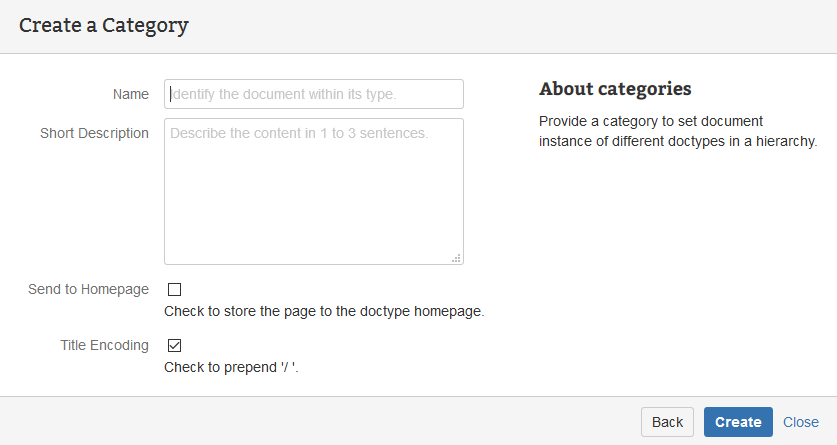Categories allow to set document instance of different doctypes in a hierarchy.
- ID
category- Suite
- Documentation Type
- Categories
- Tags
- Title Encoding
Categories allow to set document instance of different doctypes in a hierarchy.
Properties
The document type Category provides the following properties:
Please note that only information about specific properties is provided here. Common document property used by all document types are documented by Document Properties.
Short Name
The name of the category includes the path to the root category which makes the names of categories quite unwieldy. Therefore the short name is just the last part of the category path.
CSS Style Information
Add the CSS to use with this document type when rendered as an element within the Name List Macro.
If you define the property in a category document like this:

The boxes for this category will be rendered with a orange background colour. The examples shows the root category 'Communication'.

Sections
Subordinate Categories
Categories are hierarchic. This is reflected by the name of categories, which include the path to the category root.
Documents
List of documents that are associated with this category.
Per default only documents within the same space are listed. If you want to reference
Notes
These are internal notes that are usually not exported and only visible to team members with write access.
But this is not a safe place to store sensible information. It is just a convenience for the reader to not be bothered with notes stored here for the authors for later use. The security level is about suppressing the representation by a CSS style. Therefore consider this as a convenience for the reader, not as a security tool.
The text of notes sections is also indexed.
References
For a document the references section contains pointers to resources that prove the statements of the document.
Often these proofs are not easily distinguishable from further information. In this case you may want to skip the reference section in favor for the resource list.
For further information please refer to References and Resources.
Resources
The resources section provides references to further information to the topic of the document.
This may be information on the internet provided by the resource or information in the team's information systems. Anything the reader of the resource might want to know, may be listed here.
For further information please refer to References and Resources.
Details
Title Encoding
Spaces are limited such that there can only be one page with a given title. Categories typically define an alternate view on a topic. There may be other documents with the same title, but of different document types. Therefore Categories prepend a slash ('/') separated by a space in front of the name. Therefore category names look like paths in a tree (or taxonomy if you like).

You may check the box on the wizard to create a new category to care for this conventional encoding.
Available since version 1.10.
Related Doctypes
Tags
Tags are also a means to add structure to documents. Other than with categories, tags are not (required to be) hierarchic. Therefore tag names have to be unique, even if they do not have the same ancestor path, categories do only have to be unique within their ancestor path.
Type-specific Types
Besides generic types projectdoc also provides types that are associated with specific doctypes only.
| Name | Short Description | Set | Target Types |
|---|---|---|---|
Categorize associations by a type. |
|||
Categorize categories by a type. |
|||
Categorize charters by a type. |
|||
Categorize excerpts by a type. |
|||
Defines the context through which readers acquire skills. The level sets the expectation on the author's techniques to teach. |
|||
Categorize experience levels by a type. |
|||
Categorize FAQs by a type. |
|||
Categorize generic documents by a type. |
|||
Categorize glossary items by a type. |
|||
Resources are identified by their media type. This may be the MIME type, but also a human readable string, that identifies the syntactic format. |
|||
Categorize media types by their type. |
|||
Categorize metadata documents by a type. |
|||
Categorization of document modules for single sourcing. |
|||
Categorize organizations by a type. |
|||
Categorize persons by a type. |
|||
Categorize profiles by a type. |
|||
Categorize quotes by a type. |
|||
Organizes glossary items. |
|||
Categorize relations by a type. |
|||
Resources are identified by their type. This is not the MIME type, but human readable string, that identifies the semantic, rather than the syntactic format. |
|||
Categorize roles by a type. |
|||
Categorize sections by a type. |
|||
Categorize space indexes by a type. |
|||
Categorize stakeholders by a type. |
|||
Categorize steps by a type. |
|||
Categorize subjects by a type. |
|||
Categorize tags by a type. |
|||
A topic type is a semantic type of the topic. It helps to set the expectations of potential readers. |
|||
Categorize versions by a type. |
Resources
- Employ the Autolist Feature with Categories - Categories, tags, and others allow to organize the pages in your wiki. First define categories pages with display table macros. Second tag your pages with these categories. With this two-step process it is easy to have multiple views to link to your information in your wiki.
- Finding without Searching - applied! - A blog article on organizing Confluence spaces with the projectdoc Toolbox.